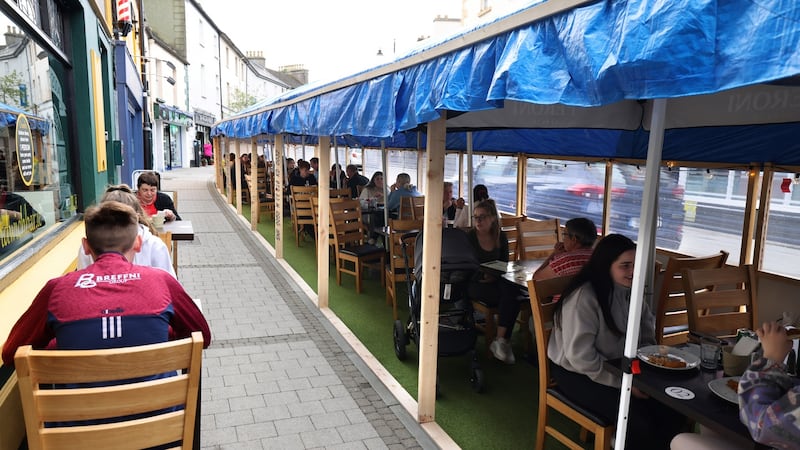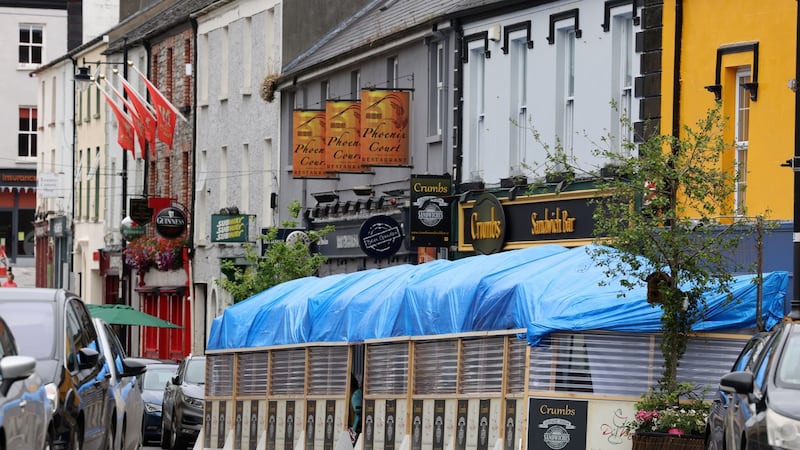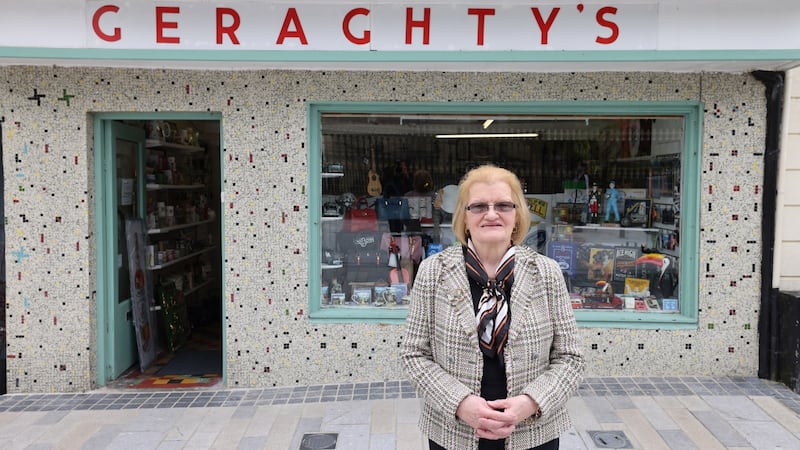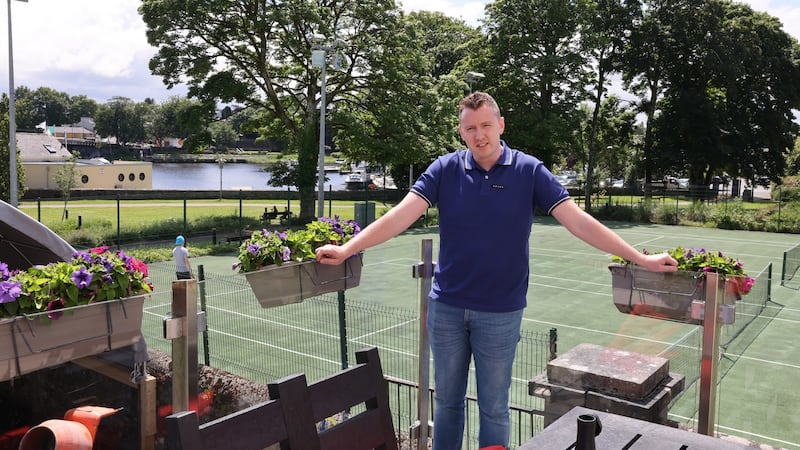Monday, June 28th
2pm
I drive into Carrick-on-Shannon in Co Leitrim – and am bamboozled immediately as to where I'm going, because the town is undergoing a year-long re-paving and roads project. There are diversions everywhere, so I see most of the town twice before I eventually locate the car park behind the Bush Hotel on Main Street.
The Bush is an atmospheric old-fashioned warren of rooms, with lovely staff, and public spaces full of cabinets filled with china and bric-a-brac. Startlingly, there is a large stuffed tiger looking out from under the raised lid of an antique grand piano in the lobby. My room, in which Michael Collins once slept, has no fewer than 23 photographs of Collins alive, and at least 10 of him dead in his coffin. There is also a pair of lace gloves sandwiched behind glass, captioned, “Kitty Kiernan’s Hand Made Lace Gloves.” Are they really her gloves, I wonder?
3pm
The Dock, a former courthouse, is the town’s beautifully renovated arts centre. It opened in 2005, and its current director is Sarah Searson. There is a 100-seater performance space, three galleries, a cafe, two workshop rooms and two artist studios. The galleries have a six-person show running until the end of August, purposefully called Second Summer.
“Our last live event was on International Women’s Day last year,” Searson says, walking me through the striking galleries, with engaging, diverse work from Jamie Cross, Ellen Duffy, Brian Fay, Fiona Finlay, Eve O’Callaghan, and David Smith.
“After that, the entire programme just got dumped.” The hardest challenge for Searson was having to cancel shows, and disappoint artists. “You get into this because you care about the artists.”
The majority of visitors to the Dock are local, and from the surrounding counties. The ever-passing tourists boating on the Shannon frequent the restaurants, but don’t tend to come to the arts centre. “I think when you are on the river, you are in a different mindset,” Searson says.

5pm
Carrick-on-Shannon, population 4,062 at the 2016 census, is indeed all about the river that flows through it. Everywhere you look, there are boats. On the water, tied up at marinas, being towed behind cars. It’s a particularly warm and sunny day, and I walk up and down the marinas in the centre of town, where people on moored boats are lying out on deck reading, or drinking, or sleeping.
John Dunne is waiting for me with his borrowed barge, the Johanna. From Carrick, now retired, he formerly worked on merchant ships and private yachts, and he's been navigating this river all his life. He even ran a hotel on a barge some years ago.
“When I was four, my father built a cabin cruiser out of an old lifeboat,” he says, as he pilots the barge down river. The repurposed boat was the beginning of a lifetime on the water. By eight, he and his similarly young friends were taking lake boats by themselves onto the river to camp overnight on islands. “River rats,” he laughs.
Dunne recalls a time when “the lock gate to Lough Key was falling down, so you had to bring along a sheet of plywood to stop it leaking”. All the locks are busy now.
I assume, as we glide along the water, passing cruisers as we go, that the Shannon boat traffic is high. "Nothing like the heyday," Dunne explains, "There used to be close to 200, 250 boats for hire. It's down to well under 100. The hire-boat sector collapsed when Ireland became a dear destination about 20 years ago: cruising was always an expensive holiday. Back then, you could only rent a boat for a week. Now you can take one for three days, or a weekend."
We had 1,600 people booked in for lunch and dinner over July, and we now have to cancel most of them
Carrick is the hub of the northern Shannon for hire boats; it’s where the journey begins or ends. “Hire boats can’t go further than Killaloe [in Co Clare], but if you have your own boat, you can go down all the way to Limerick, and out to the ocean, as many people do.”
We are moving along at about 9km/h, the yellow lilies on the water drifting back and forth; the lush green summer fields either side of us. I spot a wooden boat hidden in the reeds, next to a little swimming platform. It’s beautiful on the river; peaceful and calm. Alongside us, to our right, this bucolic scenic route from Carrick to Leitrim village, a distance of some 9km, has been designated as a pedestrian Blueway. The plan is that within the next couple of years, a pathway beside the river, partly on land, partly on floating pontoons and raised walkways, will open to the public.
“It will bring changes to Carrick and Leitrim village. We’re hoping it will do for us what the Greenway did for Westport and the villages along the way. We just hope a proposed new bypass won’t be running alongside it, which it is scheduled to do for part of it at present.”
I mention that the slow pace of the boat and the proposed Blueway walkway are both forms of “slow travel”. Dunne looks at me quizzically. “We all use the river differently,” he says. “It’s not all slow travel on the Shannon.”
Five minutes later, he calls a friend of his, whom I have mentioned I am hoping to speak to while in Carrick. It’s Kenny Murtagh, who owns the Moon River boat, which does regular river cruises.
“He’ll meet us at the dock,” Dunne says.
“Is he on the boat at the moment?” I ask.
Dunne laughs. “He’s in his back garden. But he has a speed boat, so he’ll get there before us.”
And sure enough, it is not all slow travel on the Shannon. Murtagh appears out of the horizon on his boat and catches up with us.
6.15pm
Moored back at the dock, Murtagh comes aboard the Johanna. His cruiser, Moon River, is right behind. It’s a 110 seater, that he’s been running cruises on since 1995. The boat can be rented for private events. Otherwise, most scheduled cruises are an hour, at €17 a ticket for adults. There’s a bar on board.
“Usually we’d be doing back-to-back cruises this time of year. About six in the mornings, and two in the afternoons,” he says. “We have a lot of American coach tours. Or rather, had.” At present, the Moon River is only running twice a day, at 1pm and 3pm.
Like many others in a small town, Murtagh has more than one business. “I own two bars, the Barrel Store and Murtagh’s.” He is also one of about 15 people in Carrick who cater for the many stag and hen parties that the town has become known for. This business has been entirely absent for more than a year. A package that includes accommodation (he also owns some units), a cruise on the Moon River, dinner in the bar and access to a nightclub is €150 per person. It’s usually a 10-month business for the town.

7pm
There are tables out on Bridge Street, shared by Crumbs cafe and Di Vino restaurant. I stop by to see if there is a free table, but everything is booked out for the night. I reserve a slot for the following evening. Owing to restrictions most restaurants in Carrick are not open Monday or Tuesday right now, even though it’s high summer.
I stop to take some money out of an ATM. There’s a sign on the machine over the slot where you usually post receipts: “Please don’t use for hazardous waste such as face masks”, which makes me wonder what else has been posted into it.

8pm
Cryan’s bar is doing food to the rear of its premises. Even though it’s still sunny, the tables are in the shade, and there’s a stiff breeze from the river. “Make sure your menu doesn’t fly away,” instructs my waitress, weighing it down with cutlery. I end up putting on two layers. Outdoor dining, even in summer, is simply not that warm. Walking round the town later, I notice it’s very, very quiet, with very few people visible.
Tuesday, June 29th
9.30am
I’m sitting outside the Bush Hotel, having a coffee with Joe Dolan, who runs the hotel with his wife, Rosie. Dolan is from Carrick, and has seen many changes over the decades. He confirms that there are fewer cruisers for hire on the river than 20 or so years ago.
“But there are at least 1,000 boats moored in private marinas within eight miles of Carrick, with an average capacity of four people. Effectively floating holiday homes.” (Boats are not counted in the State census.)
There are 55 rooms in the Bush, and 35 of them were full the previous night. “Tourism is the only show in town,” he says. “Carrick is Ireland’s smallest county town, and the impact of tourism is bigger here than in Galway or Kerry, because Leitrim’s population is so small. The town’s population increases by 2½ at the weekends.”

Dolan would like to see Carrick move away from being associated with stag and hen weekends, and the intermittent negative publicity they can bring. “Carrick is a big venue for weddings, and there is never a word about that,” he says. “We are repositioning ourselves. The Blueway will be great for us and the wider area. Blueways and Greenways are all the rage. With a Blueway, we’ll get a lot of product for relatively little investment. Leitrim doesn’t have any iconic attractions or buildings. The solution is creating a cluster of attractions, so that it’s not a day trip, but an overnight visit.”
I ask if the handmade lace gloves in my hotel room really did belong to Kitty Kiernan, Michael Collins’s fiancee.
Dolan chuckles. “No. But when you’re in business, you can’t let the truth get in the way of a good story.”
10.45am
There’s a notice in the window of the award-wnning Oarsman bar and restaurant, looking for a sous chef, to work a four-day week. It’s been there a month, and was also posted on social media platforms.
“We haven’t had one application,” says Ronan Maher, who has been running the premises with his brother, Conor, since 2002. They are the seventh generation of their family to work in hospitality. He looks very, very weary. It’s the day that the Government announces indoor dining, due to open up from July 5th, is indefinitely postponed.
The Oarsman has turned the front bar into a fabulous deli, which opens Thursday to Saturday. They also have provided a “click-and-collect” service. But the fact is, at this time of year, they are usually doing 140 table covers between 5pm and 9pm. We’re chatting in the freshly-refurbished back yard behind the restaurant, which will seat only 20 to 25 people depending on social distancing.
“Chefs are in short supply. Some have emigrated, some have left the industry. We are hearing staff are being poached. There are not enough wait staff. A lot of younger people are looking for work this year, but most of them don’t have any experience.” Due to the restrictions on restaurants their own staff numbers have gone from 30 to seven.
1pm
I’m in the Market Yard, having a sandwich at the Olive Tree. The Market Yard was ahead of its time, with a giant canopy already in place over half the yard’s space before the pandemic.
“Back again,” says the young woman who takes my order at the hatch. I’d eaten lunch there the previous day too. Either she has a great memory, or there are so few tourists in town, that those who are around stand out.

2.15pm
There’s a striking mosaic-tiled facade on Geraghty’s eclectic gift shop on Main Street: the tiles include several St Brigid’s crosses.
“Myself and my husband Patrick put those tiles up ourselves,” says Kathleen Geraghty (86), who is behind the counter in the shop when I go in. “We used to be a pub, that sold bicycles and televisions.”
The Geraghtys put up the tiles – which they bought in Roscommon – in 1953. The St Brigid’s crosses were in deference to the presence of St Mary’s church opposite the pub.
2.45pm
I’m trawling through Carrick’s bookshops. Antiquarian Trinity Books has a first edition of John McGahern’s Memoir for €40, and a huge hardback tome arcanely called Occult Chemistry for €120. At the Reading Room across the street, owner Orlagh Kelly tells me fiction is her current big seller. “People want to escape right now,” she says.
The Design Shop, which showcases craft and art from 70 Irish makers, has had 20 customers through its doors so far that day. Manager Emer Cunningham tells me that their biggest sellers at present are “home wares. People missed out on celebrating weddings and birthdays together, so they’re buying those gifts now.”
3.30pm
Bláithín Emmett, manager of the Red Bank Restaurant on St George's Terrace shows me around its glorious, beautifully-designed, light-filled space. It opened on March 4th, 2020, with seating for 90 and river views on the upper floor. "We closed two weeks later," she says bleakly.

Jason Horkan, who owns the Red Bank (formerly a National Irish Bank building), talks to me later by phone. "We had 1,600 people booked in for lunch and dinner over July, and we now have to cancel most of them." Horkan's priority, once he gets off the phone with me, is to get a builder help him convert their carpark into an outdoor dining space for 40-60 people. "We will have to hit more costs to try and salvage some business. To be honest, if I was a younger man, I'd be looking at trying to move into a different sector altogether."
There are some lovely walkways around the town and by the river. I spend some time wandering round the marinas, eyeing up boats, and watching swan families out on the water. It’s busy enough on the water, but there are not many people on the streets of Carrick itself, which feels oddly empty for Ireland post Midsummer’s Day.
7pm
I’m at Ging’s riverside bar, which has fully availed of its pretty garden space, with several outside tables. It has umbrellas, but the space is so exposed, being by the river, that it seems inevitable at least part of you is going to get rained on, when the rain falls again, as it most certainly will.
An hour later, I turn up for my slot at Di Vino’s. Several car-parking spaces on the street have been turned into a kind of open-sided narrow marquee, with plastic corrugated walls. The courtly waiter apologises for the lack of heaters: the street is in the shade. I’ve come prepared, with plenty of layers. Nobody, I notice, is dressed up for dinner. It’s puffa jackets, jeans, boots, shawls, and hats for all. The actual restaurant building is located across the road, so the waiters have to navigate traffic to serve tables.
My crab ravioli is hearty and delicious, and my three layers of clothing keep the breeze out. At the next table, the high-volume talk is of the Government’s current handling of the pandemic. It’s not complimentary.
“Will all this ever end?” one man in their party of four says at one point. Then he sighs, and orders another bottle of wine.


















